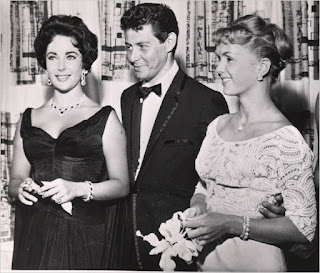Eddie Fisher, whose matinee-idol looks and smooth, romantic voice made him one of the most popular singers of the 1950s, and whose busy love life stole headlines in 1959 when he divorced Debbie Reynolds to marry Elizabeth Taylor, died on Wednesday at his home in Berkeley, Calif. He was 82. The cause was complications of hip surgery, his daughter Tricia Leigh Fisher told The Associated Press.
Mr. Fisher’s pulsing delivery and boyish looks made him a lethal heartthrob for a generation of teenage girls, who thrilled to chart-topping hits like “Wish You Were Here,” “I’m Walking Behind You,” “Oh! My Pa-Pa” and “I Need You Now.” Between 1950 and 1956 he had 24 No. 1 hits and nearly 50 songs in the Top 40. He reached a wide television audience on “Coke Time With Eddie Fisher,” which NBC broadcast from 1953 to 1957, and “The Eddie Fisher Show,” its successor.
[Emphasis added.]
He was irresistible to women, and vice versa. His career suffered badly over his very public and messy divorce from Ms. Reynolds, whom he had married in 1955 and left for Ms. Taylor.
The divorce became a major scandal partly because Mr. Fisher and Ms. Reynolds had been sold as Hollywood’s dream couple, and partly because Ms. Taylor had been married to Mr. Fisher’s best friend, the producer Mike Todd, who had died in a plane crash in 1958. The gossip columns and magazines feasted on the breakup and the romance for months, and the adverse publicity caused NBC to cancel “The Eddie Fisher Show.”
Las Vegas News Bureau-Elizabeth Taylor, left, with Eddie Fisher and Ms. Reynolds, the couple she came between, in 1958.
The divorce of Mr. Fisher and Ms. Taylor was as sensational as the marriage. The smoldering romance between Richard Burton and Ms. Taylor, ignited on the set of “Cleopatra,” burst into flame before an eagerly watching world, and in 1964 the storied Fisher-Taylor marriage came to an end. Mr. Fisher, a worldwide object of derision as the ousted party, bounced back by marrying the singer Connie Stevens, the third of his five wives.
In his heyday Mr. Fisher was romantically linked with some of Hollywood’s most glamorous women, including Kim Novak, Marlene Dietrich and Angie Dickinson. His first autobiography, published in 1981, bore the almost inevitable title “Eddie: My Life, My Loves.”
Edwin Jack Fisher was born on August 10, 1928, in Philadelphia. His parents were Jewish immigrants from Russia, and his early singing experience came at the local synagogue. At 13 he won a singing contest sponsored by the “Horn and Hardart Children’s Hour,” a radio variety show, and he soon became a regular on the Philadelphia radio station WFIL, where his starting pay of 15 cents — the price of two trolley tokens — rose to $18 a week.
“It takes many qualities to make a good singer, but your boy has the most important quality of all,” a local voice teacher told Mr. Fisher’s mother. “In his throat there is a thread of gold.”
While still in high school he sang his way into the Buddy Morrow band, a job that took him to New York and led to an engagement with the Charlie Ventura big band. Too young to appear in nightclubs, he found work as a staff singer at the Grossinger’s resort in the Catskills, where his singing caught the attention of Eddie Cantor, who booked him in 1949 on a cross-country show. A contract with RCA followed.
“In one year, this boy will be America’s most important singer of popular songs,” Cantor predicted accurately. In 1950, the year that “Thinking of You” reached No. 5 on the charts, and “Bring Back the Thrill” and “Unless” cracked the top 20, Mr. Fisher was voted America’s most promising new male vocalist in a poll of disc jockeys conducted by Billboard. He then commanded $1,000 a week as a headliner at the Paramount on Broadway.
In 1951 he was drafted into the Army, which put him to work singing with the Army Band and touring bases overseas. “The Army gave me a lot more than I gave it,” Mr. Fisher told The New York Mirror in 1953. “Why, I did shows I never would have done. In the rain, the mud, off the backs of trucks, without a mike and sometimes without even music.”
He continued to record while on furloughs and resumed his career, with scarcely a glitch, after completing his two years of service. Stepping back into the headliner role at the Paramount, he began to look like the second coming of Frank Sinatra.
Seeking to capitalize on the golden Fisher-Reynolds marriage, RKO paired the couple in the musical-comedy film “Bundle of Joy” (1956). Mr. Fisher appeared opposite Ms. Taylor in “Butterfield 8” (1960), in a dramatic role that convinced him and the rest of the world that acting was not his destiny.
The hits became scarcer after the mid-1950s, and RCA dropped him in 1960. He returned to the label and recorded the minor hit “Games That Lovers Play” in 1966. The album of the same title, made with Nelson Riddle, became his top-selling long-playing record.
Mr. Fisher then entered a long slide and filed for bankruptcy in 1970. His career problems were aggravated by addictions to drugs and gambling, which he wrote about frankly in his first memoir and its successor, “Been There, Done That” (1999).
Besides his daughter Tricia Leigh of Los Angeles, he is survived by a second daughter from his marriage to Connie Stevens, the actress Joely Fisher, also of Los Angeles; two children from his marriage to Debbie Reynolds, the actress and writer Carrie Fisher and Todd Fisher; and six grandchildren.
September 24, 2010: Eddie Fisher, Pop Singer, Dies at 82
By WILLIAM GRIMES

No comments:
Post a Comment